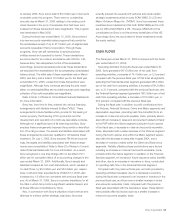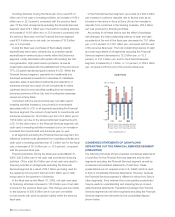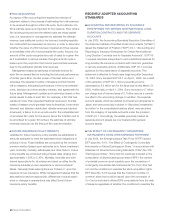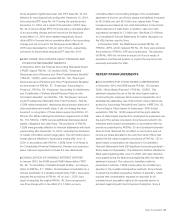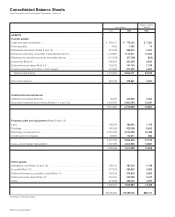Sony 2005 Annual Report Download - page 68
Download and view the complete annual report
Please find page 68 of the 2005 Sony annual report below. You can navigate through the pages in the report by either clicking on the pages listed below, or by using the keyword search tool below to find specific information within the annual report.
Sony Corporation 65
on high-quality fixed-income investments currently available and
expected to be available during the period to maturity of the
pension benefit obligation. The 2.3% discount rate represents a
10 basis point decrease from the 2.4% discount rate used for
fiscal year ended March 31, 2004 and reflects current market
interest rate conditions. For Japanese pension plans, a 10 basis
point decrease in the discount rate would increase pension
costs by approximately 1.2 billion yen for the fiscal year ending
March 31, 2006.
To determine the expected long-term rate of return on
pension plan assets, Sony considers the current and expected
asset allocations, as well as historical and expected long-term
rates of return on various categories of plan assets. For Japa-
nese pension plans, the expected long-term rate of return on
pension plan assets was 4.0% and 3.2% as of March 31, 2004
and 2005 respectively. The actual loss on pension plan assets
for the fiscal year ended March 31, 2005 was 0.1%. Actual
results that differ from the expected return on plan assets are
accumulated and amortized as a component of pension costs
over the average future service period, thereby reducing the
year-to-year volatility in pension costs. As of March 31, 2004
and 2005, Sony had unrecognized actuarial losses of 328.5
billion yen and 322.2 billion yen, respectively, including losses
related to plan assets. The unrecognized actuarial losses reflect
the overall unfavorable performance of equity markets over the
past several years and will result in an increase in pension costs
as they are recognized.
Sony recorded a liability for the unfunded accumulated benefit
obligation for Japanese pension plans of 149.4 billion yen and
128.6 billion yen as of March 31, 2004 and 2005, respectively.
This liability represents the excess of the accumulated benefit
obligation under Sony’s qualified defined benefit pension plans
over the fair value of the plans’ assets. This liability was estab-
lished by a charge to stockholders’ equity, resulting in no impact
to the accompanying consolidated statements of income.
The following table illustrates the sensitivity to a change in the
discount rate and the expected return on pension plan assets,
while holding all other assumptions constant, for Japanese
pension plans as of March 31, 2005:
CHANGE IN ASSUMPTION
Yen in billions
Pre-tax Pension Equity
PBO expense (net of tax)
25 basis point increase /
decrease in discount rate . . . –/+45.0 –/+3.0 +/–1.8
25 basis point increase /
decrease in expected
return on assets . . . . . . . . . . — –/+1.3 +/–0.8
■DEFERRED TAX ASSET VALUATION
Sony records a valuation allowance to reduce the deferred tax
assets to an amount that management believes is more likely than
not to be realized. In establishing the appropriate valuation allow-
ance for deferred tax assets (including deferred tax assets on tax
loss carry-forwards), all available evidence, both positive and
negative, is considered. Information on historical results is supple-
mented by all currently available information on future years,
because realization of deferred tax assets is dependent on
whether each tax-filing unit generates sufficient taxable income.
The estimates and assumptions used in determining future
taxable income are consistent with those used in Sony’s approved
forecasts of future operations. Although realization is not assured,
management believes it is more likely than not that all of the
deferred tax assets, less valuation allowance, will be realized.
Sony applied to file its corporate income tax return under the
consolidated tax filing system in Japan beginning with the fiscal
year ended March 31, 2004. Under the consolidated tax filing
system, the tax-filing unit consists of Sony Corporation, the
ultimate parent company of the Sony Group, and its wholly
owned Japanese subsidiaries. The eventual ability to realize the
tax benefit of its deferred tax assets is dependent on whether
the tax-filing unit as a whole will be able to generate sufficient
taxable income in the future. In addition, Sony is subject to local
income taxes in Japan. For purposes of local income taxes,
each entity is taxed as a stand alone tax filing unit. The eventual
ability to realize the tax benefit of deferred tax assets for local
income taxes is dependent on whether Sony Corporation and
each subsidiary will be able to generate sufficient taxable
income in the future. As of March 31, 2005, Sony Corporation
had deferred tax assets for local income taxes totaling 77.5
billion yen. The eventual ability to realize the tax benefit of its
deferred tax assets is dependent on whether Sony Corporation
will be able to generate sufficient taxable income in the future.
Management believes that Sony Corporation’s historical results,
when evaluated in connection with relevant qualitative factors
and available information concerning its business and industry,
provided substantial positive evidence, which outweighs the
negative evidence available. However, under recent conditions,
management considers that it is possible that Sony
Corporation’s future results may yield sufficient negative evi-
dence to support the future determination that it is more likely
than not that Sony Corporation will not realize the tax benefit of
all these deferred tax assets. If this is the case, subject to review
of relevant qualitative factors and uncertainties, Sony may
establish a valuation allowance against part or all of the deferred
tax assets of Sony Corporation. Such valuation allowances
would be charged to income as an increase in tax expense.
BH6/30 Adobe PageMaker 6.0J /PPC


